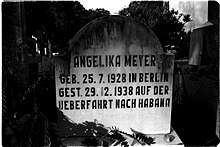History of the Jews in Cuba
Jewish Cubans, Cuban Jews, or Cubans of Jewish heritage, have lived in the nation of Cuba for centuries. Some Cubans trace Jewish ancestry to Marranos (forced converts to Christianity) who came as colonists, though few of these practice Judaism today. More than 24,000 Jews lived in Cuba in 1924, and more immigrated to the country in the 1930s. But during and after the 1959 communist revolution, 94% of the Jews left for the United States and other countries.[1] In 2007 an estimated 1,500 known Jewish Cubans remained in the country, overwhelmingly located in Havana,[2] occasionally called Jubans as a portmanteau of the English word "Jew" and Cuban. Several hundred have since emigrated to Israel.
History

There was significant Jewish immigration to Cuba in the early 20th century: from Turkey following the breakup of the Ottoman Empire and from eastern Europe and Russia. By 1924 there were 24,000 Jews in Cuba, with many working in its garment industry.[1] In the 1930s, additional Jewish immigrants came from Europe as a result of Nazi and fascist persecution; some hoped to get to the United States but decided to stay in Cuba (see also MS St. Louis). In 1959 before the Revolution, an estimated 15,000 Jews lived in Havana, where they had five synagogues.[2] More Jewish Cubans lived outside the capital.
Nearly 95% of Jewish population left Cuba for the United States after the arrival of Fidel Castro and his implementation of a communist government.[1] Additionally, between the years 1948 and 1997, 661 Cuban Jews immigrated to the State of Israel, and an additional 400 immigrated after the fall of the Soviet Union (and its significant aid to Cuba) in 1991.[3] As part of the middle class, some Jews were made to serve in forced labor camps in the 1960s, but they were not targeted as an ethnic group by Castro's government.[1]
Several Jews played prominent roles in the revolution under Castro including Fabio Grobart, Manuel (Stolik) Novigrod, and Enrique Oltuski.[4]
Since the late 20th century, a large Jewish Cuban-American community has developed in South Florida. Modern Cuba has some new communities of Middle Eastern descent, including Jewish and Lebanese populations.
The Cuban Coordinating Commission, the official governmental unit for the Jewish Community, recognized 1,201 people as Jewish in 2001 for the purpose of distributing Passover food.[1]
In February 2007 The New York Times estimated that there were about 1,500 known Jews living in Cuba, most of them (about 1,100) living in Havana.[2] Cuba has one kosher butcher shop on the entire island. For a time it had no rabbi, but by 2007, one was based in a Havana synagogue. He often encourages visiting Jewish peoples to give tzedakah (charity) for the Jewish Cubans and for Israel.[2] Alan Gross traveled to Cuba to help the small Jewish community, but he was detained in Cuba from 2009 to 2014. Some Jewish Americans originally from Cuba are also fierce critics of the Cuban regime, such as Representative Ileana Ros-Lehtinen. Israel also continues to have an embargo against Cuba.
Adath Israel is the only nominally Orthodox synagogue remaining in Cuba.[2] There are two other synagogues in Havana, in addition to a few other Cuban cites. In December 2006, the Cuban Jewish community celebrated its 100th anniversary.[1]
In 1999, actor and playwright Frank Speiser debuted his one-man play Jewbano about growing up half-Jewish and half-Cuban in Brooklyn.[5] Although primarily used in a positive sense, some confusion has arisen in the past where "Jewban" has been misinterpreted as an ethnic slur, or as a political statement (i.e. suggesting the "ban" of Jews). In 2003 the Florida Department of Highway Safety and Motor Vehicles attempted to withdraw a "JEWBAN" vanity plate which had previously been issued to Tabares Gomer, a Jewish Cuban, arguing that the plate could be considered anti-semitic. The department later relented and permitted Gomer to keep the license plate.[6]
See also
References
- "Cuba", Jewish Virtual Library
- Gerszberg, Caren Osten (4 February 2007). "In Cuba, Finding a Tiny Corner of Jewish Life" – via NYTimes.com.
- "The Jews of Cuba". The Museum of the Jewish People at Beit Hatfutsot.
- Metz, Allan (1993). "Cuban-Israeli Relations: From the Cuban Revolution to the New World Order". Cuban Studies. 23: 115.
- "One-man Show Celebrates Creator's Cuban-Jewish Roots", The Palm Beach Post (November 22, 2002), p. 40.
- "State Lets Cuban Jew Keep 'Jewban' License Plate", The Orlando Sentinel (March 15, 2003), p. B5.
Further reading
- Jay Levinson, Jewish Community of Cuba: The Golden Years, 1905–1958, Nashhville, TN: Westview Publishing Company, 2005.
External links
- "The Jews of Cuba" website
- CHAI Missions, Jewish Missions to Cuba
- "Havana", Encyclopaedia Judaica
- "Two-Hyphen Identity", Hadassah Magazine
- DANIEL SHOER-ROTH, "'JEWBAN' to state: Hands off my plate!", Miami Herald, 14 March 2003
- Sally Craigin, "Mambo mensch: Frank Speiser’s cross-cultural memoir" (Jewbano), Boston Phoenix, July 11–17, 2003
- John Lantigua, "West Palm Jews Visit to Aid Brethren in Cuba", The Miami Herald, 15 July 2009
- Paul Haven (AP), "Raul Castro celebrates Hanukkah with Cuban Jews", Seattle Post-Intelligencer, 5 December 2010

